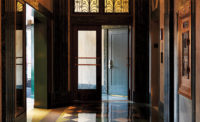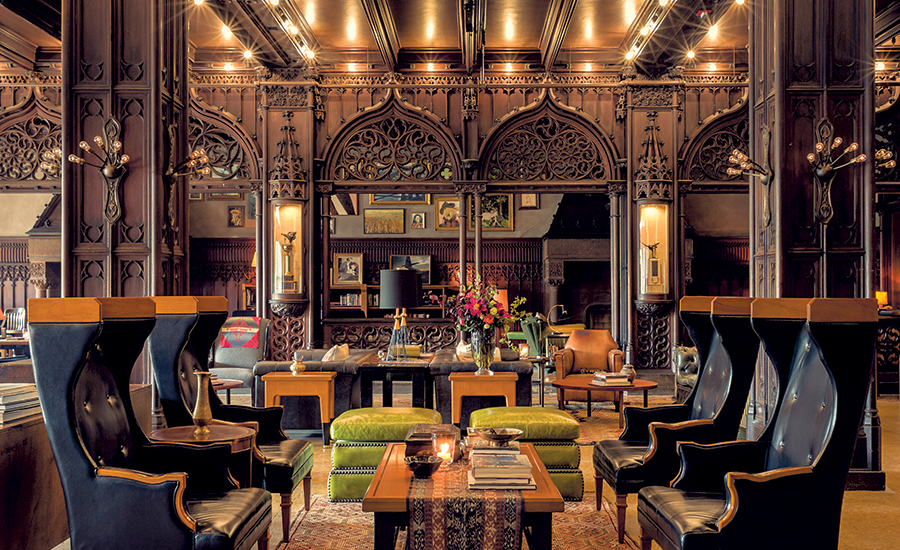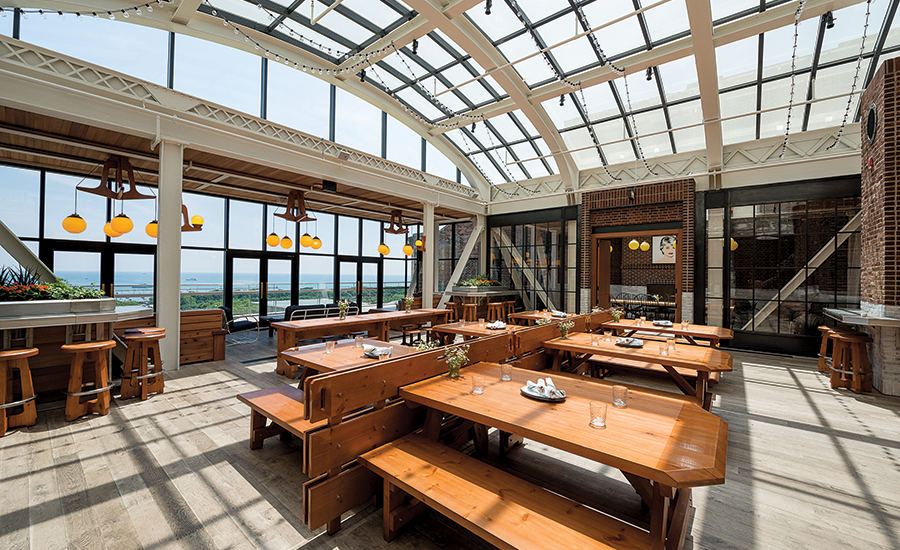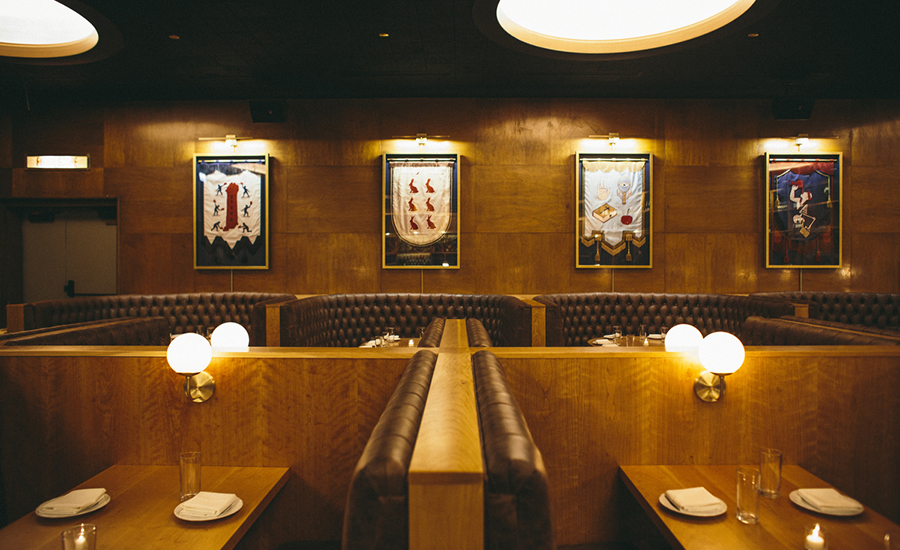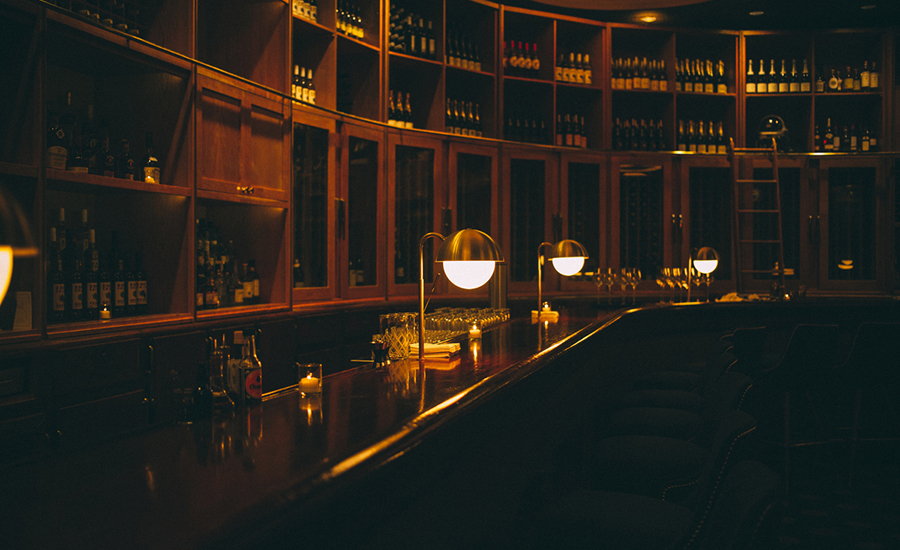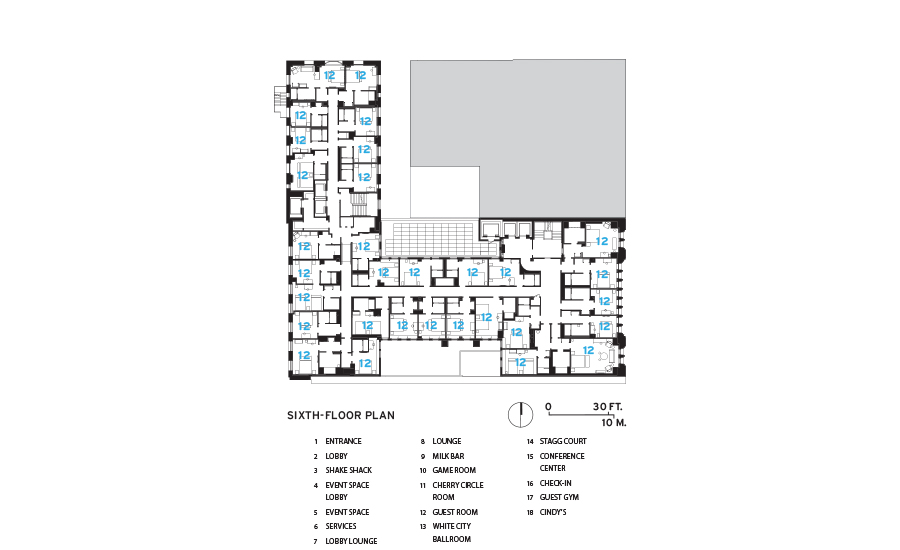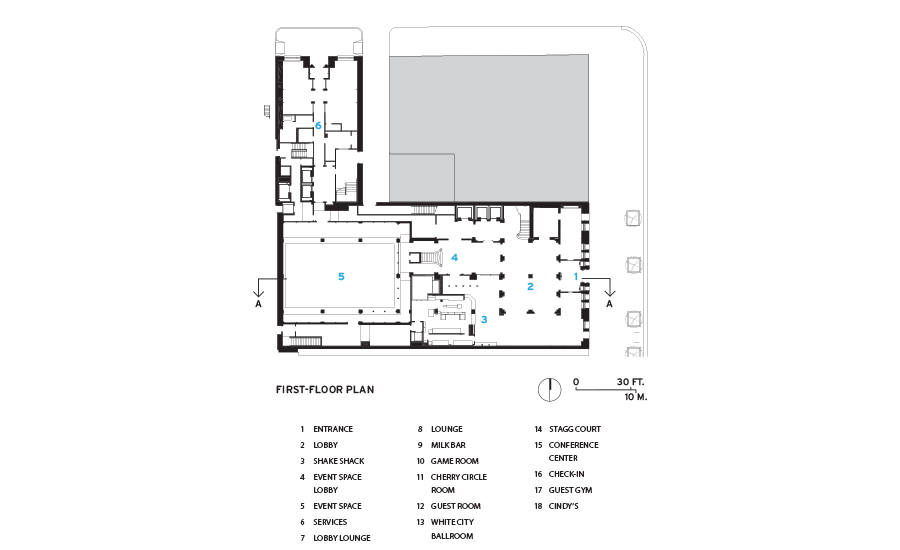Chicago Athletic Association Hotel
Chicago

The restored rosy brick and delicate screen of limestone columns and pointed arches signal the main entrance to a hotel bearing Henry Ives Cobb’s 1893 Chicago Athletic Association’s name.
Photo © Alan Shortall

The Venetian Gothic style extends through the main lobby on the second floor.
Photo © Alan Shortall

The reception desk is one of several new millwork pieces designed to evoke the layered, lacquered, and leather-embellished vintage athletic equipment. The mural over the desk depicts the elevated train tracks that encircle Chicago’s Loop.
Photo © Alan Shortall

The original stair of marble, cast bronze, and gilded cast iron has been impeccably restored.
Photo © Brad Pogatetz

The newly added rootop bar and restaurant features a steel and glass pavilion that draws inspiration from 19th-century train sheds.
Photo © Brad Pogatetz

The guest rooms have a masculine look that recalls the hotel’s origins as a club for men including a leather bench resembling a gymnasts’ pommel horse.
Photo © Alan Shortall

The restored original millwork in the Lobby Lounge includes fligree screens that separate the central space from more intimate alcoves.
Photo © Alan Shortall

Restored by Land and Sea Dept.
Photo © Clayton Hauck

Restored by Land and Sea Dept.
Photo © Clayton Hauck

Restored by Land and Sea Dept.
Photo © Clayton Hauck

Restored by Land and Sea Dept.
Photo © Clayton Hauck

Image courtesy Hartshorne Plunkard Architecture, Roman and Williams Buildings and Interiors

Image courtesy Hartshorne Plunkard Architecture, Roman and Williams Buildings and Interiors

Image courtesy Hartshorne Plunkard Architecture, Roman and Williams Buildings and Interiors

Image courtesy Hartshorne Plunkard Architecture, Roman and Williams Buildings and Interiors















On Chicago’s stately Michigan Avenue, steps from the Art Institute, in a classically ordered ground-floor lobby with elaborate mosaic floors, Corinthian columns, and two grand marble stairs, office workers in “business casual” line up for burgers at Shake Shack. On the grand piano nobile above, amid the plutocratic splendor of a plushly furnished lounge with intricate paneling, monumental fireplaces, and leaded-glass windows overlooking Millennium Park, twentysomethings in T-shirts and jeans tap away at laptops and smartphones. In an adjacent game room, they down local craft beers while playing pool and bocce. This is not your grandfather’s Chicago Athletic Association (CAA), where Cyrus McCormick and Marshall Field used to exercise, dine, and dance. No, it’s the new CAA Hotel, for which the home of an august but defunct institution has been rescued, repurposed, and rebranded for a more diverse demographic.
A casual knowledge of Chicago’s architectural history might suggest that, as the 20th century approached, new buildings fell neatly into two stylistic camps: the muscular structural expressionism of the Chicago School and the Beaux Arts classicism of the World’s Columbian Exposition of 1893. Among the notable exceptions were buildings in fanciful period styles such as the 11-story CAA, Henry Ives Cobb’s sumptuous Venetian Gothic palazzo. Completed the same year as the exposition, its facade of rosy brick with a delicate screen of creamy limestone columns and pointed arches recalls the Doge’s Palace. In 1906, Schmidt, Garden & Martin added a 12th-story annex for a second ballroom and women’s dining; in 1926 the firm extended the height to 19 stories to add more guest rooms.
The CAA served the city’s elite for over a century, but in 2007, dwindling membership forced it to close. Developers proposed to save the front third of the building but destroy the annexes; the recession mercifully killed this scheme. In 2012, John Pritzker, son of Hyatt Hotels founder Jay Pritzker, spearheaded a purchase by AJ Capital Partners, Agman Partners, and Geolo Capital for $13 million. The goal was to reinvent the venerable landmarked L-shaped structure as a 241-room luxury hotel under the Commune Hotels + Resorts brand, of which Pritzker is chairman.
In renovating the club as a hotel, Hartshorne Plunkard Architecture (HPA) and New York–based designers Roman and Williams (RW) eschewed the kind of makeover that strives to restore to a fixed date, with any new elements suppressed in a simulacrum of the original. Neither did they want to create modernist interventions in which original elements are preserved as artifacts and new elements assert themselves in a contemporary style. For the CAA, the team carefully developed a nuanced approach: they opted for discreet insertions that tie together many previous alterations and additions, stressing evolution over time.
“This is an approach to renovating and reinvigorating historic buildings that we have developed and refined over the years,” explains RW principal Stephen Alesch. “The project was not envisioned as a museum restoration,” seconds HPA principal Paul Alessandro, who found the building to be “an embarrassment of riches,” adding, “It was clear from the outset that we could never do something better than the original, and inserting something aggressively modern felt like cheating. We had to be very careful.”
And careful they were. The exhaustive rehabilitation included the restoration of 18,000 square feet of ornamental plaster, 26,500 square feet of marble and mosaic flooring, 32,000 square feet of paneling and bas-reliefs, and 82 art glass windows, along with the recreation of 151 plaster stalactites in the ceiling of the White City Ballroom on the eighth floor of the original building. The Michigan Avenue entrance canopy is a reproduction based on original 1890 drawings.
A tour of the second (main) floor offers a timeline of the club’s history. Teams of craftsmen restored the 1893 grandeur of the Lobby Lounge by removing, refinishing, and reinstalling every piece of millwork and recreating original light fixtures from old photos. The reception desk is one of several new pieces designed to evoke the layered, lacquered, and leather-embellished construction of vintage athletic equipment. The adjacent Game Room is a lively hybrid of old and new, in which the original 1893 Billiard Room has been left more or less intact, but its walls have been fitted with sport-themed cartoon sketches on chalkboard, salvaged wood gymnasium flooring, and a back bar decorated with a surprisingly elegant pool cue rack. The eclectic space provides an artful transition to the refurbished midcentury swank of the 1954 Cherry Circle Room, sheathed in flush oak paneling and tufted leather banquettes.
Guest rooms recall the club’s sporting past with masculine-looking armoires, desks, and bars derived from wooden stretching racks and leather benches that resemble gymnasts’ pommel horses. Vintage oriental rugs, a modern twist on the brass bed, and national-parks blankets add a layer of richness and comfort. Bathrooms are crisp and classic, combining white porcelain tile and fixtures with Carrara marble vanities and nickel fittings.
HPA added two floors to the 1893 Cobb design, including a 12th floor for mechanical space and a 6,000-square-foot rooftop aerie for drinking and dining. Crowned by a vaulted skylight, it required additional structural muscle: new cantilevered trusses rest on original columns that were reinforced throughout the building and then underpinned at their foundations. The design team drew inspiration for the new steel and glass pavilion from the late 19th-century train sheds that once occupied the ravine across Michigan Avenue, now covered by Millennium Park. The result is nonetheless a thoroughly modern, light, and airy bar and restaurant, named Cindy’s, after Mr. Pritzker’s mother. It opens to a terrace with postcard views that include Frank Gehry’s music pavilion, named after Cindy’s husband, Jay. In Cindy’s portrait, which overlooks a private dining room, she appears to be smiling—and with good reason.
PeopleArchitect Hartshorne Plunkard Architecture Personnel in architect's firm who should receive special credit Jim Plunkard, AIA – Partner | Project Role: Managing Partner Interior designer Roman and Williams Buildings and Interiors Engineers MEP/FP Engineer Structural Engineer Exterior Restoration and Structural Façade Engineer Consultants Lighting: Acoustical: Project Manager: Historic Advisor: Other: Art Advisory Service (Art Consultant and Procurement) Neil Locke & Associates (Procurement) General contractor Bulley & Andrews, LLC Masonry Restoration Bulley & Andrews Masonry Restoration, LLC Photographer Brad Pogatetz Photography CAD system, project management, or other software used AutoCAD Revit Design Suite Client AJ Capital Partners, Agman Partners, Geolo Capital partnership
Size 249,000 square feet Cost withheld Completion date May 2015 |
ProductsStructural system Clay Tile Protected Steel Frame with Exterior Masonry Bearing Walls Exterior cladding Metal Panels: Kingspan USA Entrance Canopy (custom): Louis Hoffman Co. Roofing LiveRoof Windows Wood frame: Jensen Window Corporation Metal frame: Graham Architectural Products Corp. Glazing Glass: Opal Glass Studios Skylights: Super Sky Products Enterprises, LCC Glass handrail on rooftop, vertical walls of insulating glass; shower doors in guestrooms: Oldcastle BuildingEnvelope Hardware Saflok Interior finishes Paints and stains: Sherwin Williams Paneling: Bernhard Woodwork Ltd. Bourbon Marble, Inc. RG Construction Services, Inc. Furnishings Office furniture: Other furniture (use additional sheet if necessary): Decca Hospitality Lighting Archistoric Products Siena Design Inc Custom Plumbing Fixtures |


